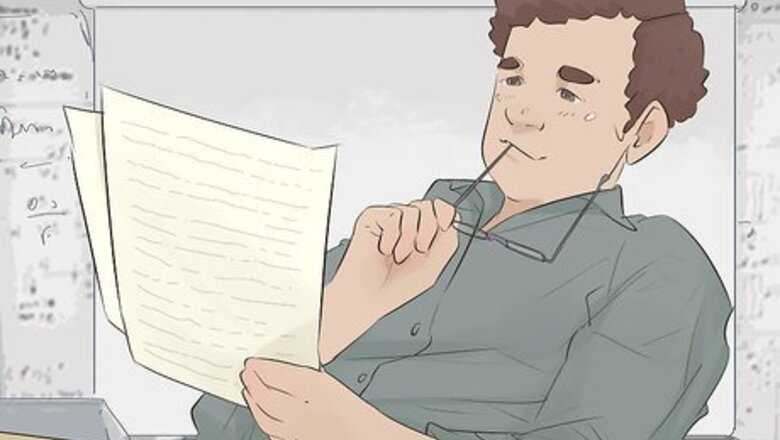
views
Choosing an Exam Style
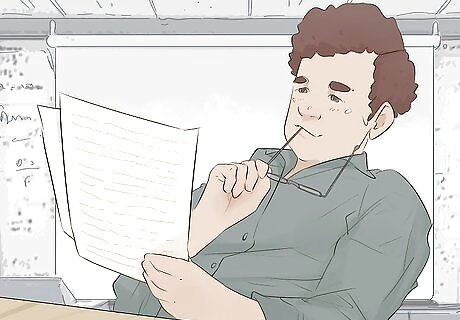
Identify what you want the exam to assess in your students. You may want to test how much new knowledge your students have acquired and are able to accurately recall, or simply give them a way to practice what they’ve been studying in the course. Knowing why you’re giving your students an exam will help you to determine how best to design that exam. For example, if the goal of your exam is to test how much new knowledge your students have accumulated in the class, you might design an exam that asks them true-or-false or fill-in-the-blank questions about facts you’ve covered in the course. Or you may want to ask questions that test new skills you want your students to have, such as critical thinking, written communication, or logical reasoning. What you want your exam to assess in your students will determine the type of questions you ultimately come up with. It’s imperative that you have a clear purpose for your exam before you write it to prevent it from being a waste of your and your students’ time. It’s also vital for your students to understand the purpose of the exam, so make sure you communicate that clearly.

Align the exam’s purpose with the objectives of the course. Identify ahead of time which course objectives and learning outcomes you want the exam to address. Then, you’ll be better prepared to write questions and focus on content that will specifically test whether students have achieved these learning outcomes. For example, if you’re teaching a course on American history, you may craft an exam that gauges whether students can accurately describe major themes in American history or recall historically significant names and dates. The objectives and learning outcomes for your course should also have been stated in the course outline or syllabus. It’s also important to clearly define how much material each exam will cover. For example, for an American history class, an exam might cover a particular class unit or historical period rather than all of American history.
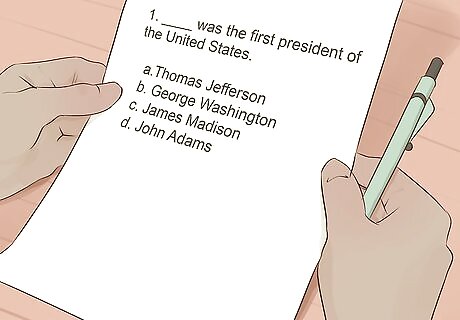
Use multiple choice and fill-in-the-blank questions to test recall. You’ll probably want your exam to test your students to some extent on how much they can accurately recall the factual knowledge they’re meant to have acquired in your course. To do this, use fill-in-the-blank or multiple choice questions in which the correct answers are specific words or phrases from the course material. For example, to test students’ knowledge of historical facts, you might write a multiple choice question asking them to select the correct year in which a particular event took place. Conversely, you might write a question asking them to remember a specific detail like a name, such as in the question: “____ was the first president of the United States.”
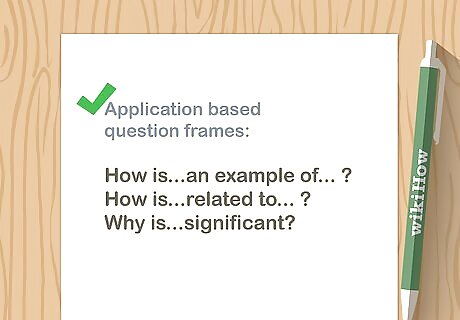
Test synthesis and knowledge application with short answer and essay questions. Short answer and essay questions are ideal for testing higher level thinking skills, such as analysis, critical thinking, and synthesis of knowledge. Write these questions on broad concepts and general issues from the course rather than specific details. For instance, instead of asking the type of detail-specific question used in a multiple choice question, you might instead write a question that asks students to critically evaluate and explain the 3 most important factors that led to the American Revolution.

Combine question types to allow equal opportunity for your students. Try to mix up the types of questions that you write as best you can to allow students who struggle with 1 type of question the opportunity to do better with other question types. This will also make your exams more cognitively complex and better able to test your students’ intellectual growth. For instance, it would be better to write an exam that includes some multiple choice questions, some short response questions, and some essay questions, rather than an exam that is solely composed of 1 type of question. The frequency with which you use a certain type of question will depend on what you want your test to assess. For example, if you want to prioritize testing your students’ recall abilities, fill-in-the-blank or multiple choice questions would be best. If you want to assess students’ written communication skills, open-ended essay questions would be ideal.
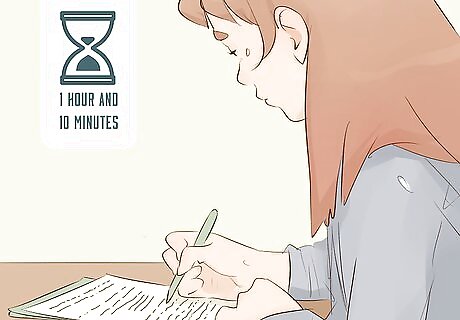
Base the length of the exam on how much time students have to take it. You need to be realistic about how many questions your students can adequately answer in the limited amount of time they have to take the exam. Limit the number and type of questions you use based on how much time is allotted for the exam, giving more time for essay questions and less time for multiple choice and fill-in-the-blank questions. For example, if your students only have 1 hour and 10 minutes to complete the exam, you might write the exam with 20 multiple choice questions (allotting 1 minute per question), 4 short answer questions (allotting 5 minutes per question), and 1 essay question (allotting 30 minutes per question). The amount of time your students will need for each part of the exam will vary based on factors like their age and grade level. Talk to colleagues who have taught your course or a similar one about how long each test section should be.

Make your exam “open-book” if you want to make your questions more analytical. Although you’ll want to challenge your students through your exam, you don’t want them to struggle just for the sake of it. Allowing your students to use their notes or the book will enable you to write questions that test their analytical and critical thinking skills more than their factual recall. You should ultimately aim to test students in a way that they’ll be familiar with, thus allowing your students to appreciate the value of the exam as a way of testing their learning outcomes in the course. If your students feel that you’re trying to trick them or psych them out, they will be resentful of the exam and perhaps also of the entire class. If your test is open-book, you may need to give your students more time or limit how much reference material they can use. The process of looking through the material for information will cut into the time it takes for the students to actually write out their answers.
Crafting Questions

Create a list of the main topics covered in your course. Go through your past lectures, the textbook, and the course outline to identify the central topics, ideas, and themes that have been covered throughout the course. You’ll refer to this list to come up with questions for your exam. As part of this process, it’s a good idea to clearly define the beginning and end points of the material you plan to cover. For example, the main topics in a course on early American history might include the reasons behind the American Revolution, the principles of early republican government, and the geographical expansion of the country. Be sure that you don’t add any topics to the list that your students have not encountered in the class. The content of the exam needs to be recognizable to all of your students. Try to focus on broad, overarching topics that have been covered throughout the course, rather than topics you only touched on in passing (unless those topics are very significant). For example, if you spent less than 10 minutes in one lecture discussing dark matter, your astrophysics exam should not include more than 1 or 2 small questions on the subject.

Write questions that test students’ real understanding of these topics. Don’t come up with questions that test whether students can recall minute, nitpicky details that may have been covered in the course, but weren’t important in the long run. Instead, focus on creating questions that gauge whether students grasp the central concepts and themes that you’ve covered throughout the length of the course. For example, if you’re creating questions for an exam on American history, avoid asking students questions like “What was the name of Robert E. Lee’s horse?” Although you may have mentioned this fact in a lecture, it’s more than likely not relevant to the overall theme of the course itself. Remember, your exam should give students the opportunity to demonstrate how much they’ve learned from the course, not whether or not you can stump them.
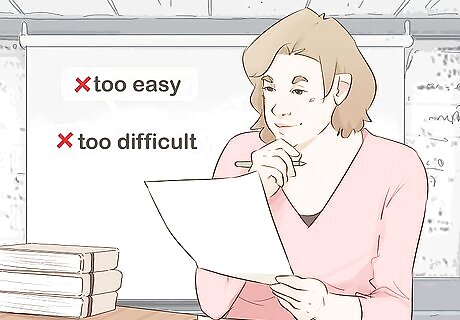
Refrain from writing questions that are too easy or too difficult. While your test questions should be demanding, they should not be so difficult that your students are generally unable to answer them. At the same time, you don’t want your questions to be so easy that your students aren’t challenged. Be realistic about what you can expect your students to know and understand based on the course content and write your questions accordingly. The best way to make sure a test question isn’t too difficult is to simply use your own judgment: ask yourself whether a student who has attended your lectures and read the assigned material would reasonably be able to answer your question without struggling for too much time. If you’re not sure whether your questions are too difficult, ask a colleague who has taught your class before to read over your exam and give feedback on your questions. They will have more experience with administering and grading exams and will have a good sense of what students can be expected to know by this point in the course. It may be hard to tell whether your questions are too easy or difficult until you’ve written the whole test. Once you see them all together, you’ll have a better sense of which questions don’t fit well with the overall difficulty level of the exam.

Review past exams and your textbook for inspiration. If you’ve created exams for your class in the past, look over those exams for ideas on what sort of questions you might ask in your current class. Your textbook also probably has suggested questions that you can use to craft your own exam questions. There are also many resources for educators online that you can use to craft exam questions. If you’re a K-12 educator, check the website for your local school district or state board of education for suggested exam questions. If this is your first time teaching the class, see if you can ask a colleague who has taught the class before for their previous exams.
Checking for Difficulty
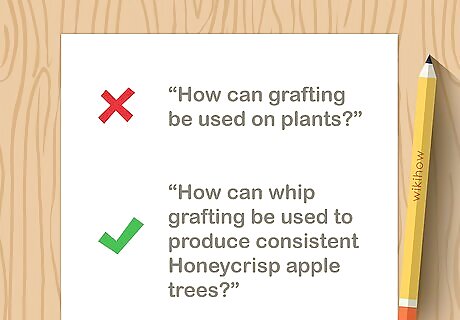
Write instructions for the exam that are explicit and unambiguous. The students should be able to read the question and know exactly what you want them to do. Otherwise, they may inadvertently answer the question incorrectly. Keep your instructions clear and concise. Don’t confuse or overwhelm your students by over-explaining things. You might also consider explaining how fully you want your students to answer short-response or essay questions to avoid them spending too much or too little time on such questions.

Make sure your questions are written in clear, simple language. The questions need to be easy for students to understand so that they’re able to concentrate on test content rather than format. Avoid using complex sentences, double negatives, or academic jargon that might trip up students taking the exam. This is especially important if you have any students for whom English is not their first language.

Ask a TA or colleague to read through your exam for you. It may be hard for you to spot ambiguous or confusing language in the exam if you wrote it yourself. Take the finished product to a fellow instructor and ask them if they could look it over for you to make sure the language is clear. If possible, see if your colleague would be willing to take the entire exam, just to make sure its length and difficulty level are acceptable.
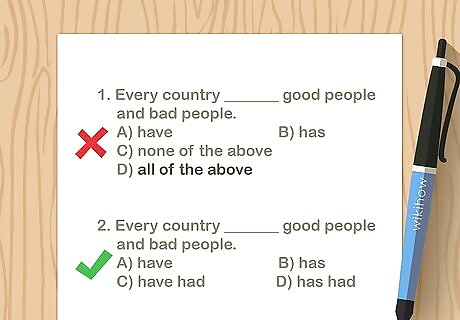
Confirm that each question only has 1 possible answer. Go through all the multiple choice and fill-in-the-blank questions and ensure there’s only 1 correct answer that students can possibly give. For short answer questions, make sure they’re worded in such a way that only 1 answer would be considered correct. For example, instead of asking for any example of a particular phenomenon in a biology exam, ask instead for the best, most impactful, or most common example of a particular phenomenon. It will be difficult, if not impossible, to write essay questions that have only 1 possible correct answer. Instead, write essay questions so that students have to provide specific answers (e.g., “Describe in detail the 4 phases of mitosis”) that are grounded in factual accuracy.

















Comments
0 comment